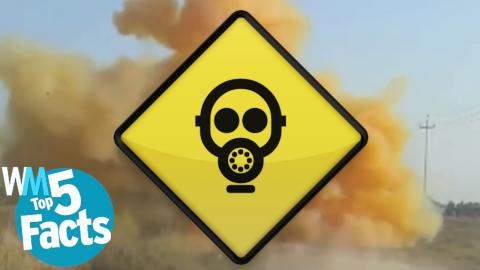Top 5 Facts about Chemical Weapons

Let's talk about some of humankind's most horrifying inventions. Welcome to WatchMojo's Top 5 Facts. In today's instalment we're counting down the Top 5 Facts about Chemical Weapons.
Come along as we explore these terrifying substances and the unnerving realistic threat they pose in our modern world.
And just a WARNING: This video may include graphic imagery.
#5: It Has Some Grizzly Subcategories
Not all Chemical Weapons are created equal, but they are all awful in their own special way. The various chemical methods of inflicting serious bodily harm or bringing about excruciating death generally fall into 4 categories. Choking agents, like chlorine or phosphine gas result in suffocation. Blister agents, such as mustard gas, are chemical irritants that cause extreme skin blisters. Blood agents, typically cyanide or arsenic based, make it so that oxygen cannot be properly transported in the blood. Last, but perhaps most sickening, are nerve agents. Absorbed through the skin or lungs, even a small dose of such a chemical, like sarin gas, can wreak havoc on the nervous system, with severe lifelong side effects.
#4:There Are Countries that HAVEN'T Signed the Chemical Weapons Ban
Considering how inhumane chemical weapons are, it’s little surprise that the international community has a long history of coming together to agree on NOT using them. As of today, most of the world’s governments support the Chemical Weapons Convention. As of 2016, it’s estimated that roughly 93% of the world’s stockpile has been destroyed. What is surprising however, is the fact that a few countries have refused to get onboard. While Israel has signed the treaty, they have yet to ratify it. Syria and Angola finally became parties to the treaty in 2013 and 2016 respectively. This leaves just three countries - Egypt, North Korea and South Sudan - who have taken NO steps towards joining the rest of the world on this issue.
#3: There Are Some Disconcerting Weapons NOT Banned
While the 1997 Chemical Weapons Convention is by far the most successful and detail-oriented treaty of it’s kind, it is not without its shortcomings. Some of the biggest outliers include napalm and white phosphorus. The latter is allowed on the grounds that it be used to create a camouflaging smoke and not as a weapon. What this ignores however, are the numerous indirect effects it can have even in that application - such as toxic fumes and deadly burns. As for napalm, it is allegedly used primarily as an incendiary, and not a chemical. Another curious group omitted are biological weapons. While they have their very own treaty, the Biological Weapons Convention, it lacks any sort of verification or monitoring system.
#2: The Short and Long Term Effects
One cannot truly grasp the horrors of chemical warfare without taking a look at the grizzly details. Pulmonary agents fill your lungs with fluids, giving one the feeling that they are drowning from the inside. Nerve agents often prove deadly, and should you receive a fatal dose… your remaining minutes will likely be spending violent seizuring and twitching as your nervous system collapses. Mustard gas on the other hand, is a latent killer with long-term side effects. According to the CDC, only 5% of people exposed to it in WWI died. The many individuals affected, however, were often severely disfigured, and suffered chronic respiratory conditions later in life. Mustard Gas goes more than skin deep, actually damaging human DNA. As a result, the likelihood of birth defects among children born to those exposed are much higher.
#1: It's Been Used More Recently Than You Think
According to the Organization for the Prohibition of Chemical Weapons, “over 98% of the world’s population lives within territories” that respect the Chemical Weapon Convention. And yet… they are still used to this day. We tend to think of examples involving terrorists, like Aum Shinrikyo’s use of sarin in the 1995 Tokyo subway attack, or the reported use of chlorine and mustard gas by ISIS since 2014 in both Syria and Iraq. But the most recent display of chemical weapons wasn’t an act of terrorism… it was the work of a government - more specifically, the Syrian government. According to a report by Human Rights Watch, “the pattern of the chlorine attacks shows that they were coordinated with the overall military strategy for retaking Aleppo, not the work of a few rogue elements”. Worse yet, they were carried out in residential, civilian areas.
